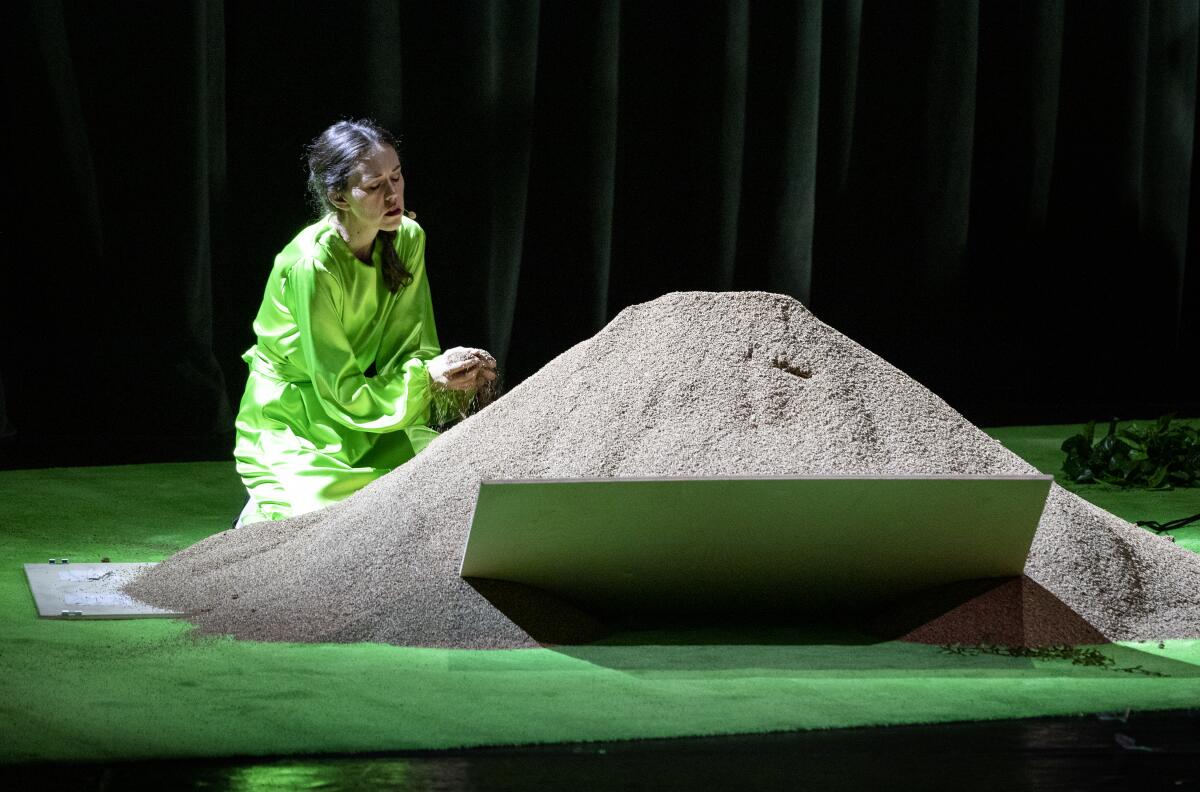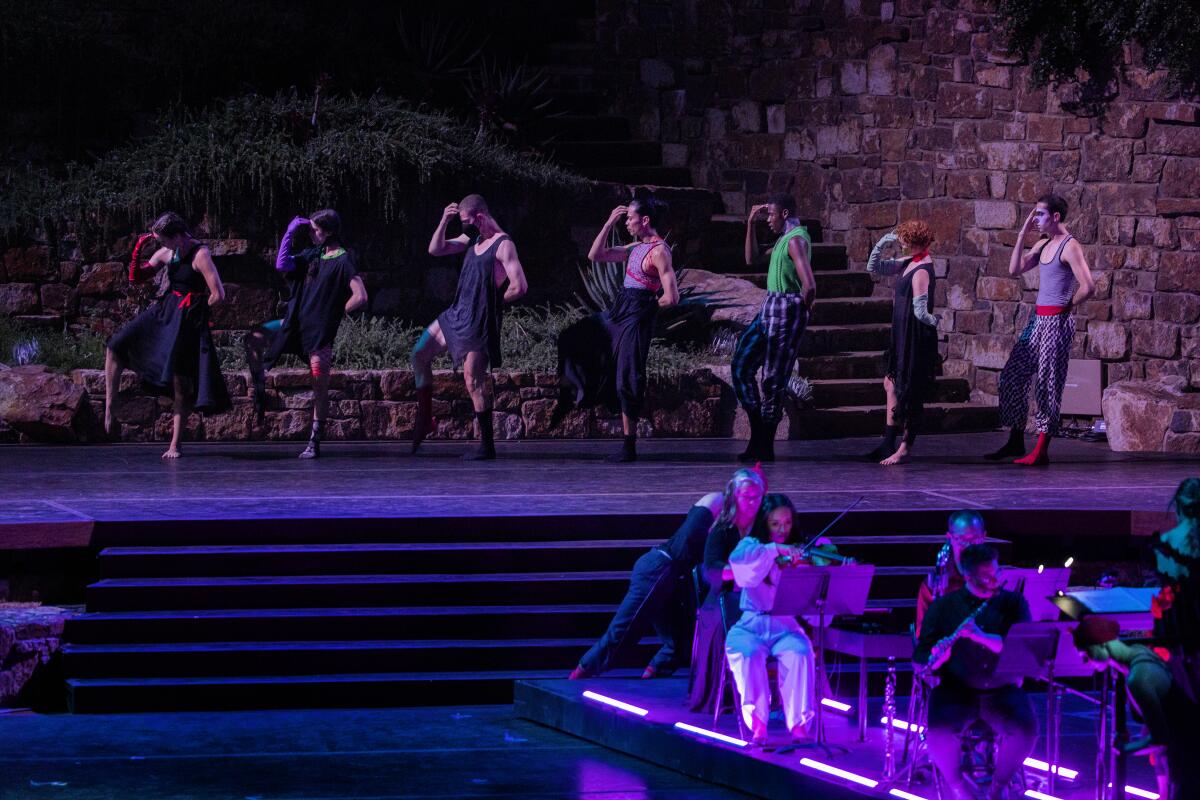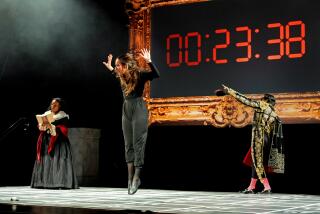Review: An astounding singer lifts Long Beach Opera’s ‘Killing Jar’ at the Ford

Long Beach Opera is on the move, although it is too soon to say to what or where or when. The pandemic squashed what might have been the most imaginative season, as devised by interim artistic advisor Yuval Sharon, of any American opera company this year.
Saved was a production of Philip Glass’ “Les Enfants Terribles” uneasily transferred in May to a Long Beach parking structure by James Darrah, who has been named the company’s new artistic director and chief creative officer. Saved, too, was an enticingly frenzied double-bill of monodramas mounted at the Ford over the weekend.
Neither Schoenberg’s 20th century classic “Pierrot Lunaire” nor Kate Soper’s striking 2012 “Voices From the Killing Jar” is an opera, not that it matters. Each is a 40-minute rivetingly dramatic tour-de-force for a female singer/reciter/performance artist. Soper, moreover, pays homage to “Pierrot” a century after, modifying what has become known as the “Pierrot” ensemble of flute, clarinet, violin, cello and piano and employing electronics.
She further pays homage to Pierrot’s salaciously surreal madness with eight songs for mad women, or more accurately women driven to distraction by abusive men. Nothing can be more traditionally operatic than that.
Each work had a different director and concept. Neither Darrah nor Sharon nor the company’s indispensable new music director, Christopher Rountree, were on hand. A new season has been announced for next year that will take the company in directions that are new (reimagining Handel’s “Giustino”) and old (remounting, in a new production, Anthony Davis’ gripping, Pulitzer Prize-winning “Central Park Five”).
There will be video, for sure, because Darrah has been pandemic-producing so much of it for Los Angeles Chamber Orchestra, Boston Lyric Opera, Opera Philadelphia and Music Academy of the West. There was none at the Ford, although there was dance for “Pierrot.”
But put all of that aside for a moment. I’ve buried the lead. A star should have been born two years ago when Rountree mounted Ragnar Kjartansson’s “Bliss” for the Los Angeles Philharmonic. A three-minute snippet of redemption at the end of Mozart’s “The Marriage of Figaro” is repeated nonstop for 12 merciless hours. Through it all, forgiveness is given by the Countess Almaviva to her faithless husband in a seemingly impossible number of ways, making this the ultimate woman’s revenge in opera. The Countess on that occasion was a local singer, familiar for showing up in performances here and there, part of the ensemble in new music or maybe a church offering. She was one of many in “Sweet Land” and other notable projects.
Given a star turn like no other in “Bliss,” though, Laurel Irene simply astounded. Given a star turn as the soloist in “Voices From the Killing Jar,” she astounded once more Sunday night, if in radically different ways. The evidence is in. A major singer — one who seems as if she can do anything — is practically hiding in our midst.
Coronavirus may have silenced our symphony halls, taking away the essential communal experience of the concert as we know it, but The Times invites you to join us on a different kind of shared journey: a new series on listening.
“Killing Jar” is a striking work. The mad scenes come from a wide range of literature, be it Greek tragedy or Haruki Murakami’s “The Wind-Up Bird Chronicle.” Emma Bovary shows up, as do Lady Macduff from “Macbeth” and Daisy from “The Great Gatsby.” Pain and angst are a common emotional language among them, although each is wild in her own way.
The instrumental ensemble creates an eerie atmosphere, often with creepy harmonies and harmonics and strange percussive effects from everyone, not just percussion. They also play tunes. Electronics distort and when in full immersion mode take over the Ford, a great site for multi-channel mayhem. In the last part, centered on Daisy, the environment turned hostile when a helicopter hovered above the Ford and chopped-chopped-chopped throughout the entire section.
It is to Soper’s and especially Irene’s credit that the chopper did so little musical damage. By this point, Irene had run the emotional and the vocal gamut with her screams and her creamy lyric lines. With exacting virtuosity, she tore up the scenery but not her vocal cords, assumed new characters with instant ease, vomited vines and hung herself. She had the audience in a thrall that no flying musical war machine could stop. Soper’s disembodied texts and ever-changing music also proved intriguing enough to keep distraction at bay.
The production had few fussy touches — a chandelier stood for something or other, there was a scenic sand pile — but mainly it put Irene front and center, and that was exactly what was needed.

“Pierrot,” staged as a dance drama by choreographer Danielle Agami for her company Ate9, was otherwise. There are few composers whose music is more resistant to dance than Schoenberg, despite the dance forms he often applies in his scores. In concert, a listener can feel overwhelmed by the extreme intricacies of Schoenberg’s instrumental score and the dramatic peculiarities of the spoken-sung vocal solo, with the recitation pitch-based and rhythmically precise.
Albert Giraud’s Surrealist text adds another dimension as we try to come to terms with the amoral, moon-drunk Pierrot, the clown-maker of nightmares who has no business emerging from deep within our subconscious. That’s already a dimension or two too many for most of us. Agami added characterful movement — interesting to look at, but too much to look at along with the titles translating the German text.
That soprano Kiera Duffy contended with it all, and that the musicians (lined in a row, except for the distant piano, on a platform that dancers pushed around) didn’t simply lose it, was impressive. Perhaps Duffy was overamplified to compensate for being so often overshadowed onstage, but that made her sound abrasive, and she is not an abrasive singer. Jenny Wong’s conducting was broad and rhythmic. There was no place for nuance to fit into the concept.
That is not to say that the performance failed. As a kind of dance evocation of “Pierrot Lunaire,” it contained power to hold the stage. And that may have been Long Beach Opera’s idea with both pieces. The program notes, which you had to find on your phone, gave almost no pertinent information about either piece. Context went the way of nuance.
But Irene is not to be forgotten in her killing of “Killing Jar.” The only “Pierrot” equivalent may be the new recording narrated by and conducted by violinist Patricia Kopatchinskaja, who creates a one-woman overwhelming experience. Listen to it loud and your brain will dance.
Nichelle Nichols, the beloved Lt. Uhura on ‘Star Trek,’ is living with dementia and struggling financially. Three parties fight to control her fate.
More to Read
The biggest entertainment stories
Get our big stories about Hollywood, film, television, music, arts, culture and more right in your inbox as soon as they publish.
You may occasionally receive promotional content from the Los Angeles Times.









